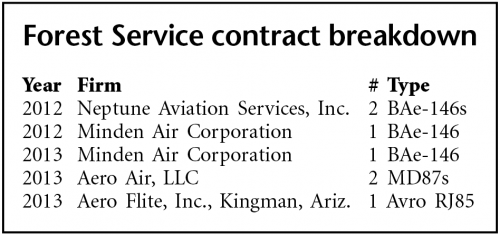The Forest Service has been adding to its air resources during the past three weeks.
First, the agency announced the award of four contracts to separate companies for seven next generation air tankers. The second step was the addition of adding four heavy helicopters to the aviation firefighting fleet.
The helicopters will be available this summer for large fire support and initial attack to any location in the United States. Helicopters are used primarily for dropping retardant or water during wildland fires, supporting the actions of firefighters on the ground. The additional helicopter assets will strengthen the agency’s capability to respond effectively to fire activity during the summer wildfire season.
On Saturday, June 24, the Forest Service took a third step to augment its air resources. Four Department of Defense C-130s equipped with Modular Airborne Firefighting Systems were mobilized to assist with wildfire suppression efforts in Colorado and elsewhere in the Rocky Mountains and the Southwest.
MAFFS are portable fire retardant delivery systems that can be inserted into military C-130 aircraft to convert them into large airtankers when needed. Military C-130s equipped with MAFFS can drop up to 3,000 gallons of fire retardant on wildfires. They can discharge their entire load in under five seconds or make variable drops.
We are mobilizing MAFFS to ensure that we continue to have adequate air tanker capability as we experience very challenging wildfire conditions in Colorado and elsewhere in the Rocky Mountain and Southwest regions,” said U.S. Forest Service Chief Tom Tidwell
In order to sign the air tanker contracts, the Forest Service needed special legislation that expedites the Forest Service contracting process that had been underway.
These exclusive use contracts were awarded to Neptune Aviation Services, Inc. of Missoula, Mont.; Minden Air Corporation of Minden, Nev.; Aero Air, LLC in Hillsboro, Ore.; and Aero Flite, Inc. of Kingman, Ariz.
The agency was required by statute to wait to award these contracts for 30 days after notifying Congress of its intent to award them. However, the agency’s request to Congress to waive a waiting period required by the Federal Acquisition Regulation was supported by Sen. Ron Wyden (D, Oregon) and other lawmakers and enabled the agency to accelerate contracting the aircraft.
Under the contracts, the four companies will provide three next generation airtankers in 2012 and four next generation airtankers in 2013. (See table.)
The contracts allow these companies to provide additional next generation airtankers beyond 2013 contingent on available funding and other circumstances.
The contracts are for a base period of five years, with five one-year options for contracts awarded for 2012, and four one-year options for contracts awarded for 2013.
All of the next generation airtankers are turbine powered, can carry a minimum of 2,400 gallons of retardant, and have a cruise speed of at least 300 knots when fully loaded. The companies that are providing them are required in their contracts to comply with stringent safety requirements.











